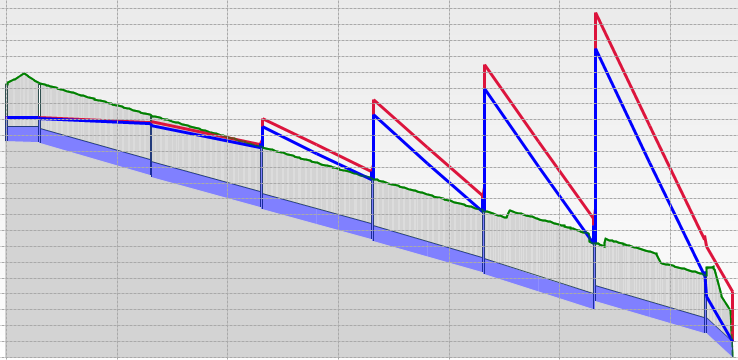| Applies To |
|
| Product(s): |
SewerCAD, StormCAD, SewerGEMS, CivilStorm |
| Version(s): |
10.00.xx.xx, 08.11.xx.xx |
| Area: |
Modeling |
| Original Author: |
Scott Kampa, Bentley Technical Support Group |
Problem Description
Why is the HGL reset to rim elevation for flooded structures in profile view with StormCAD (GVF-Rational solver) or SewerCAD (GVF-Convex solver)? Why does it appear to jump / drop in profile view like in the below screenshot?
How is flooding handled in StormCAD or SewerCAD?

Applicable products and solvers
This article applies to SewerCAD and StormCAD as well as the GVF-Rational and GVF-Convex numerical solvers in SewerGEMS and CivilStorm.
For information on how overflow and flooding is handled with the Implicit and Explicit (SWMM) dynamic solvers in SewerGEMS and CivilStorm see this article.
Steps to Resolve
Flooding at manholes and inlets in StormCAD and SewerCAD occurs whenever the hydraulic grade is above the structure rim elevation. When this occurs, the backwater analysis will continue by resetting the hydraulic grade to the structure rim elevation or ground elevation, whichever is higher. However, if a structure is defined with a bolted cover, the hydraulic grade is not reset to the rim elevation and surcharging will occur. Inlet capture is not impacted as it assumes no tailwater/backwater effects since StormCAD is used to design systems so that this does not occur.
In actual flooding situations, overflow may be diverted away from the structure and out of the system, or attenuated due to surcharged storage. In StormCAD and SewerCAD however, even though the governing downstream boundary for the next-upstream conduit is artificially lowered to prevent the propagation of an incorrect backwater, the peak discharges at the structure are conserved and are not reduced by the occurrence of flooding at a junction.
Basically, when you see the hydraulic grade reset at the structure like in the above screenshot, the structure is flooding and the system is very likely undersized. You should however keep in mind that the results are skewed in this case compared to a real system where some flow would exit where flooding occurs. This could be considered conservative since all the flow stays in the pipe (rather than some of it overflowing and reducing the flow in the next downstream pipe).
As for the resetting of the HGL to the rim, without being able to compute the overflow rate, the only alternative assumption would be to allow the HGL rise to continue as the backwater calculations continued upstream (as if the node had a bolted cover and could pressurize) which would still provide invalid results (both in the lack of overflow and in the high HGL). In a real overflowing system, the HGL would likely be slightly above the rim elevation (relatively small flooding depth), so resetting the HGL to the rim could be considered closer to reality for the hydraulic grade (compared to allowing surcharge).
Regardless when you see this flooding condition (and the accompanying user notification), it is an indication that the system is undersized and the results aren’t really valid. If you need to account for flooding/overflow, the Implicit or Explicit dynamic solvers available in CivilStorm or SewerGEMS would be more appropriate as they can calculate overflow and the resulting flooding HGL above the rim.
If you must use the StormCAD or SewerCAD and need to account for or assess the magnitude of the overflow, one possible workaround is detailed in this forum discussion:
First, replace all of the catchment runoff flows with manually entered flow values (like 'Flow (Additional Subsurface)' or 'Flow (Known)'). Next, adjust those flows in a series of model runs, increasing them until the HGL just begins to reach the rim elevation at an inlet. The difference between the manually entered flow value (when the HGL just reaches the inlet rim elevation) and the flow values due to catchment runoff computed by StormCAD would be a very rough approximation of the overflow rate.
Note: The StormCAD and SewerCAD solver's algorithm is fundamentally based on a backwater analysis. As a result, a continuous frontwater analysis is not performed through two or more consecutive steep pipes.
See Also
Overflow or Flooding Impact on Inlet Capture for StormCAD (GVF-Rational solver)
StormCAD inlet surging
Hydraulic grade discontinuity at steep pipes or across nodes (frontwater analysis)
SewerGEMS and CivilStorm: How to find volume (such as overflow volume) through specific elements